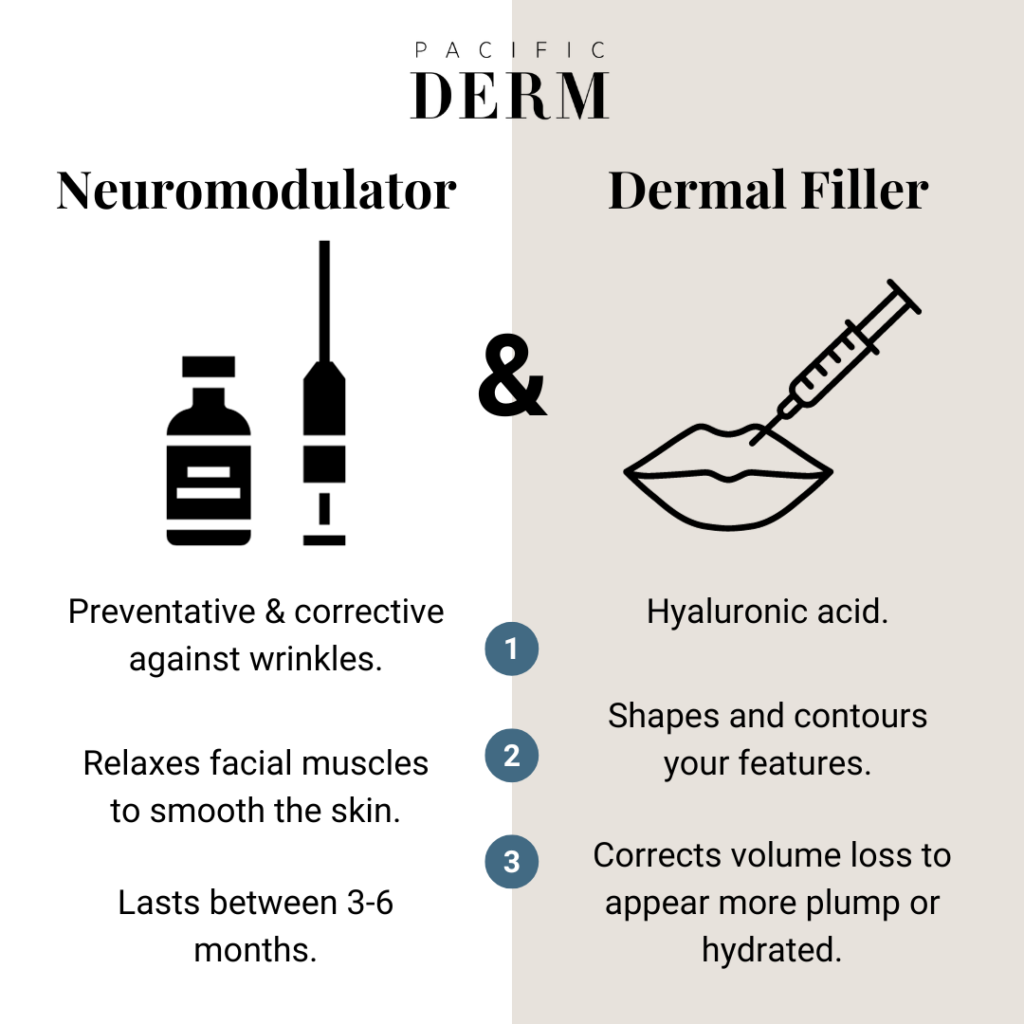Having the right information is crucial for making informed choices and achieving optimal results with cosmetic procedures, including neuromodulators and fillers.
Understanding the distinctions between these procedures is vital. For instance, are Botox and fillers the same, and is it possible to combine them?
At Pacific Derm, in Vancouver, British Columbia, we expertly blend Botox and fillers to enhance your natural beauty and achieve a refreshed, youthful appearance.
This article will address the common question: “Are Botox and fillers the same thing?”
What are Botox and Fillers?
Botox, a well-known term, is basically a brand name, for instance, how we say Kleenex instead of tissues. Other FDA-approved neurotoxins you should be aware of:
- Dysport
- Xeomin
- Nuceiva
Neuromodulators, like Botox, work to temporarily and safely immobilize muscle contraction. This results in relaxed muscles and smoother overlying skin, effectively managing wrinkles and fine lines.
They can also be used to manage excessive sweating (hyperhidrosis) and migraines.
On the other hand, fillers are crafted for injecting into the skin to bring back lost volume, giving a more youthful and rejuvenated look. Since most fillers mimic the natural Hyaluronic acid our bodies produce, they’re safe with minimal risks of adverse reactions.
Common filler materials include:
- Hyaluronic Acid (e.g., Restylane, Juvéderm)
- Poly-L-Lactic Acid (PLLA) (e.g., Sculptra)
- Calcium Hydroxylapatite (CaHA) (e.g., Radiesse)
Apart from just replacing lost volume, some fillers do other things.
For example, PLLA stimulates collagen production, offering more structural support to the skin. Hyaluronic acid fillers attract water molecules, increasing hydration in the treated area and restoring even more volume.
The Differences Between Botox and Fillers

Differences between neuromodulator and dermal filler
When it comes to enhancing your appearance, it’s important to know the differences between Botox and fillers. To simplify, we’ll break down the distinctions between Botox and fillers into the following categories:
- How they work
- Where they are used
- Side effects
- Duration of results
- Cost of treatment
-
How They Work
The fundamental contrast in the mechanisms of action between Botox and fillers centers around their distinct targets.
Botox, functioning as a neurotoxin, temporarily obstructs nerve signals responsible for muscle contractions, inducing muscle relaxation.
In contrast, dermal fillers, as injectable substances, aim to augment volume beneath the skin’s surface. They offer support and enhance skin plumpness.
-
Where They Are Used
While there is some overlap in the areas of treatment, the typical applications could be different.
Botox is commonly administered in specific facial zones, including the forehead, frown lines between the eyebrows, and the corners of the eyes (crow’s feet). It can even be applied to the masseter muscle for managing jaw pain and teeth grinding.
Conversely, fillers extend into softer facial tissues such as the lips, neck, and décolletage.
-
Side Effects
Common side effects are shared between Botox and fillers, such as temporary redness, mild swelling, and pain at the injection site.
However, variations arise from their individual modes of action.
Botox, acting on muscle activity, poses a rare risk of adverse effects like temporary muscle weakness or drooping in the treated area.
Conversely, fillers, being injected substances, may induce unwanted effects due to the introduction of a foreign substance, particularly in cases of known allergens.
Prompt reporting of any side effects to the treatment provider is essential.
-
Duration of Results
Duration varies among individuals, influenced by factors such as adherence to post-treatment instructions, baseline skin needs, and the specific treated area.
Generally, Botox results last around 4 months, while fillers exhibit a broader duration ranging from 6 to 18 months.
-
Cost of Treatment
Typically, Botox is priced per unit, with the required units varying based on the treatment area and individual objectives.
Dermal fillers are priced per syringe, with the quantity determined by the desired enhancement extent and the specific filler type.
Botox and Fillers: Can They Be Combined?
One word: yes.
The combination of Botox and dermal fillers proves to be highly effective.
Botox, specializing in the relaxation of facial muscles, addresses dynamic wrinkles resulting from repetitive muscle movements, such as crow’s feet and frown lines. In contrast, fillers focus on static wrinkles, like laugh lines, by adding volume to specific areas.
An additional advantage of this combination is the reduced need for sessions, leading to decreased time spent at the clinic and a swifter recovery for a prompt return to one’s regular routine.
This combined approach yields a naturally refreshed and harmoniously balanced appearance.
Get Started with Pacific Derm
Reach out today, and let’s explore your options toward an even more confident and refreshed version of yourself.